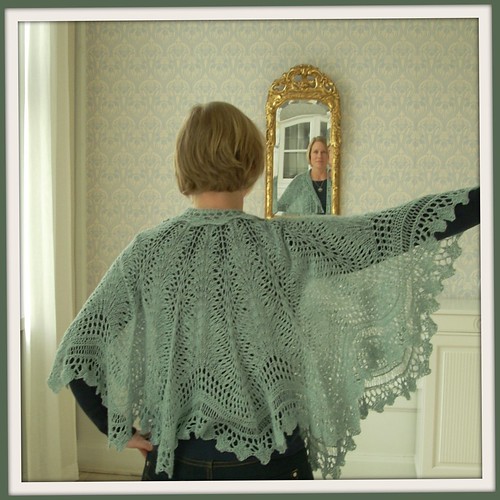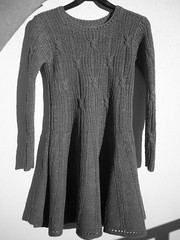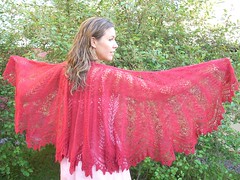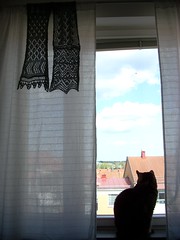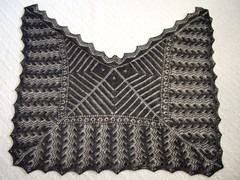 |
| And here's a car that put a smile on my face this morning. |
Wednesday, 28 March 2012
Lady's Circular Cape
Sunday, 19 February 2012
"Lady's circular cape" in progress
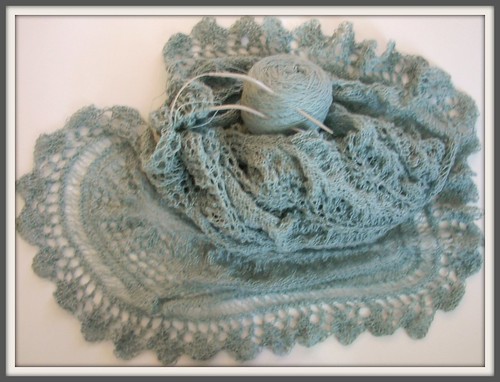
"Lady's circular cape" in progress, a photo by Asplund on Flickr.
I'm knitting Jane Sowerby's "Lady's circular cape" from Victorian Lace Today for the third time with some new modifications. The scalloped egde is rather pointed in the original design, and I'm trying to achieve a softer outline by redistributing the decreases. (Not so many next to each other but spread more evenly across the repeat.) The yarn is Drops Lace, a blend of baby alpaca and silk. Knitting the edge around it is rather boring, but I know it will be worth it once it's done.
Something completely off topic that makes me laugh:
För tredje gången gör jag en sjal ur "Victorian Lace Today" av Jane Sowerby, fast nu med nya ändringar; jag försöker göra formen mjukare, inte så spetsig, genom att fördela hoptagningarna på ett annat sätt. (Inte så många på raken, utan mer utspridda över rapporten.)
Min fiskartröja är äntligen klar! Nu ligger den på tork, och jag hoppas kunna prova den i morgon bitti. Jag brukar låta tröjor ligga på tork med avigsidan ut när jag har sköljt och sträckt dem - det är lite lättare att få sömmarna raka på det sättet.
Friday, 18 March 2011
Shawl shape
You can see a tiny sketch of the shape in the centre of the photo, and in the upper right corner is the start of the grid pattern. The shawl will be framed with a knitted-on border, but I haven't made up my mind about what kind of pattern to use. No need to decide yet, though...
Christine has passed on an award to me, a Stylish award, which is very flattering. Thank you! I'm supposed to write seven things about myself. That will require some thinking, so I'm saving that for next post. In the meantime, I suggest you check out her blog and the other bloggers she nominated.
Last, I'm going to answer a couple of questions in comments on a previous post:
Ron asked about the yarn. It's "Viva" from Wetterhoff in Finland, easily my favourite yarn for knitting lace. It's a glorious wool-silk blend (70-30%) and 100 grams is enough for a big shawl. It drapes beautifully thanks to the silk, and it has a sheen that enhances lace patterns. I just counted my "Viva" projects on Ravelry: this is my tenth since I first discovered more or less exactly two years ago. For most of them I've used 4 mm needles (US 6), but after some swatching I decided 3½ mm (US 4) worked best to make Estonian nupp patterns.
Ann asked about the edge. I simply slip the first stitch, as if to knit on the right side and as if to purl on the wrong side. I find this makes it easy to pick up stitches for a knitted-on border, and at the same time it looks nice enough in case I don't have enough yarn for a border and the shawl has to be naked. (Shock horror!)
Ron also asked about the green shawl I mentinoned in a previous post. It hasn't found an owner yet, but I have a friend's friend in mind. I understand she'd be interested in having one, and I believe it would be a great colour for her.
Edited to add: I just learnt a new word I could relate to instantly, namely shawlcoholic! Liisa's pun sjalkoholist is even better in Swedish, but I think it works in English too.
Wednesday, 10 November 2010
Two finished objects
The colour looks a bit strange in the original photo, so I thought I might as well make a black and white version. This was a nice project to knit, quick once past the first few inches and the shape is different from what I usually knit.
Trying something new is always rewarding! Combining alpaca and linen was a good idea too (not mine but suggested at my LYS). We'll just see how my cousin likes wearing it: the garment is rather heavy, almost 800 grams.
The shawl I wrote about in my previous post is also finished. For the bottom border I chose the border from "The Opera Fichu", also in Victorian Lace Today. As mentioned, I wanted fairly simple lace patterns using this yarn and since I've knitted the fichu before I knew it would curl - I simply cast it off loosely from the wrong side, not bothering about a knitted-on border around the shawl (which I normally like).
As mentioned, I wanted fairly simple lace patterns using this yarn and since I've knitted the fichu before I knew it would curl - I simply cast it off loosely from the wrong side, not bothering about a knitted-on border around the shawl (which I normally like).
My plan is to make it a guest shawl, for people to borrow when they visit. We had quite a lot of snow yesterday, but today is rather wet and windy. And cold: a guest could definitely need a shawl.
Thursday, 4 November 2010
Possession
Less surprising is my ability to buy yarn. Last weekend I couldn't resist buying two hanks of beautiful natural grey "Töis", soft and light 1ply wool from the island of Gotland.
This wool is quite fuzzy, so I wanted a fairly simple design, something based on straight lines (intricate lace patterns would drown) and decided to return to Jane Sowerby's Spider-web's shawls in Victorian Lace Today. I've made use of it twice before, for Eva and for Anna; in both cases I used wool-silk blend Viva, but I think it works with this yarn too. Come to think of it, starting Eva's shawl coincided with starting this blog!
It takes 5½ hours to go from Uppsala to Västervik, so I managed to get quite a lot done even though I kept alternating between this project and a fascinating book I'm reading, Possession by A.S. Byatt. Read a chapter, think about it while knitting for a while, read another chapter... A great way to digest a great book!
Sunday, 29 August 2010
A head of cabbage?
Not quite. Less compact! Would you believe it, I managed to cram all the stitches around the shawl onto a single circular needle! Lace is stretchy, of course, but before picking up stitches around this shape I armed myself with three needles, certain I would have to juggle with them and risking my eyes while knitting the lace edging around the shawl.
The pattern is a modification of an edging in Jane Sowerby's Victorian Lace Today, my Lace Bible.

Last week a Norwegian book I'd sent for arrived, wonderful Usynlege trådar i strikkekunsten ("Invisible threads in the art of knitting") by Annemor Sundbö, who was at the knitting camp I attended a few weeks ago.
Now, I know I'm being really immature, that I should focus on what a treasure the book is with its wealth of patterns and pictures and texts about different aspects of the socio-cultural history of knitting, and on what a great writer and lecturer Sundbö is. I know my Norwegian neighbours must be sick and tired of Swedes' childish comments. I know that words that look identical often have different meanings, even in closely related languages.
However... (You could see that word coming!) The cover does make me laugh. The name of the publishing house would always look, say, rather suggestive to Swedish eyes. Next to a well-worn mitten I'd say it's perfectly mind-boggling.
Thursday, 3 June 2010
Happy shawl!
Friday, 21 May 2010
Before and after
This is a project I will associate with many pleasant things; to name just two:
1. The memorable afternoon I met up with fellow Raveler Ian to go yarn hunting in Stockholm. This yarn was my prey.
2. The company of my greatcolleagues. We started a knitting and sewing group a couple of months ago, and last night Mimmi invited us and our projects to her beautiful house outside Uppsala. After a long and unusually cold winter, being able to spend a warm and light evening in a garden felt almost surreal. We were quite spoiled too: home-made rhubarb pie and elderflower juice. Delicious!
Saturday, 15 May 2010
Circular Cape no 2
One of my favourite yarns is Wetterhoff's Viva, a shimmering wool-silk blend - like knitting with champagne! I recently found three skeins in a colour I hadn't seen before and thought it was my duty to buy them, and it didn't take more than a couple of days to decide what to use them for.
I'm knitting "Lady's Circular Cape in Shell Pattern" by Jane Sowerby (Victorian Lace Today), a design I first knitted exactly a year ago and gave to my aunt ("Lady Caroline's Circular Cape"). This one will be "Lady Annika's Circular Cape", for a dear friend and shawl lover who's moving back to Sweden after quite a few years abroad. Hooray!
Some modifications:
1. Wedge-shaped repeats elongated with increase rows placed more regularly in the original pattern, where it grows very quickly towards the end.
2. 5 repeats instead of 12 to keep her extra warm in the winter.
3. Edging knitted with slightly thinner needles.
Feel like something new for your computer desktop? How about some elephants from Mattias Inks?
Tuesday, 26 May 2009
Cape cast off, shawl cast on
Knitting the border that runs around the whole garment did get mind-blowingly tedious in the long run, I must admit, but it's a wonderful finishing touch that I wouldn't have wanted to leave out. Some things are definitely worth the perseverance it takes to make them.
The cape is very light, perhaps 120 grams of the 350 grams I bought. What to do with the remaining yarn? Well, after knitting several lace shawls of different shapes, some with and some without modifications, I think I'm ready to try designing my own lace shawl! I really liked the shape that consists of three triangles, so it will be one like that.
While knitting another shawl last month I thought the patterns resembled rain and flowers, so I'm working with that idea. (That is, until I change my mind.) There are drop-like pattern shapes of different sizes to begin with and my plan is to fill next border with flower shapes of some kind.

Thursday, 14 May 2009
New knitting group but familiar faces

There were about 15 knitters there; I didn't know all of them but the ones I did know (like mothers of old class mates – no fathers in sight, strangely enough!) I recognized immediately or in an instant. Speaking of mothers, my mother joined me and it's nice sharing this day with her: it wouldn't have been the same thing just telling her about what it was like. Unfortunately, my sister was busy, but I hope there will be more opportunities.
The picture above shows where I lived as a child – and knitted, of course. If I remember correctly, it is actually where my grandmother showed me how to knit during one of her visits.
 I've started knitting Jane Sowerby's "Lady's Circular Cape in Shell Pattern" (Victorian Lace Today) with the pale pink wool-silk blend that I tricked myself into buying last week. Sooo easy to trick sometimes!
I've started knitting Jane Sowerby's "Lady's Circular Cape in Shell Pattern" (Victorian Lace Today) with the pale pink wool-silk blend that I tricked myself into buying last week. Sooo easy to trick sometimes!An enjoyable project, even though it looks like assorted intestines right now...
Monday, 11 May 2009
A quick fix and a slow one
Yesterday I surprised myself by finishing two projects, a fichu cast on last week and a scarf cast on last year; this made me think about what makes some things quick to knit and others slow.
Obviously, it’s a question of motivation – but in my case it doesn't seem to have much to do with level of difficulty. The scarf certainly wasn’t more difficult to knit, on the contrary. My sister chose the yarn and we agreed I’d knit a scarf with various patterns: she liked the idea of a scarf with a lot of variation in it, and I liked the idea of being able to test different lace patterns. Therefore, I really should have been able to finish it ages ago.
It was far less complicated than I expected from the photos of the finished garment, but still very enjoyable learning how to knit it.
What is time-consuming about the fichu is the number of stitches: a border row consists of more than a thousand stitches, which is something of a paradox considering it’s a fairly small garment. However, the border pattern isn't very difficult; a repeat is six stitches wide and consists of two rows, one of which is knits only. I must admit it was rather monotonous, but then it didn't require much concentration so I could knit it even when it was getting late and I was getting tired.
What, then, is important for me to really get into a project? These seem to be the main factors:
- A plan. Not necessarily knowing all the details but a general idea about the construction of the garment and what it will look like. You could say I like having a plan that I can change if I want to. (I did change some things in the fichu pattern, but let's not go down that road right now...) Perhaps the scarf idea was too vague: knit different patterns until you run out of yarn or it is long enough. Well, at least it seemed like a good idea in September.
- Variation is important. Why then do I complain about a scarf that practically consists of variation? A strong sense of democracy: only a few lines above I complained about how monotonous the fichu border was, so in all fairness it's my duty to find fault with the scarf. I'm probably too much of a control freak: I like controlled variation, knowing the different elements will blend well. Perhaps you could compare it to colours. I don't mix all the colours and shades of colours I like in the same garment, but combine the ones I believe look good together.
- Developing my skills by learning new things, testing ideas and stretching my limits - that's both exciting and rewarding. And I did get to test patterns making the scarf.
- My personal taste. Call me selfish – I do! – but in my opinion life is simply too short for me to knit things I'm not that fond of.
Now, the scarf was a good project, worth knitting not just because I learnt more about myself as a knitter, but because my sister is pleased with the results. That's an important factor too, of course. But can you use the scarf to dress up as Rasputin, which is possible with the fichu?
Thursday, 7 May 2009
Sometimes I'm efficient
Last night I met up with two groups of knitters, first at a café in Finspång and then in this beautiful house in Ljusfallshammar.
What's more, they were all into twined knitting (Sw. "tvåändsstickning") so it was an unusual and unusually pleasant evening.

I even managed to buy some yarn: seven hanks of wool-silk blend, enough for at least two shawls.
Not that I need shawls, but I do need to make them (Dr Asplund's orders) and I think "Lady's circular cape in shell pattern" would be lovely in this pale pink hue. Where the pattern is? Victorian Lace Today, of course.
Tuesday, 5 May 2009
Eva's shawl finished
Both major and minor changes to the design made it quite exciting to see if the shawl would look anything like what I had in mind! It actually does, so I'm happy with my modifications:
1) adding three small groups of holes near the top of each triangle;
.JPG)
3) the edging I "designed" (sounds fancy!) to frame three sides of the shawl; the points are formed by increases and decreases, their width based on the number of stitches in the repeats; I used yarn-over increases to make groups of holes for decoration and to make the edging elastic. (I tried invisible increases first, but I thought that made the edging look too solid compared to the rest of the shawl; it seemed too tight too.)
4) adding a knitted-on border, basically "Mrs. Hope's Vandyke edging" (also in Victorian Lace Today) except I skipped two rows (15-16) to make it match the number of stitches picked up along the edge.
It's ca 120 cm (47 in) wide and very light, ca 120 grams (1/4 lb). Eva hasn't seen the finished shawl yet; those who have tried it on say they like the shape, since it doesn't slide off the shoulders the way a triangular shawl easily does. However, it keeps your arms free rather than covered, so if you want a shawl to keep your arms warm this might not be the best choice.
Monday, 20 April 2009
Third pattern section taking shape
 Now that I've reknitted a couple of inches I'm glad I decided to change the third pattern.
Now that I've reknitted a couple of inches I'm glad I decided to change the third pattern. The pattern I've replaced it with and which looks a bit like leaves is from the "Cap shawl" (also in Victorian Lace Today) and I think it works well with the border above it. Now those circles almost resemble flowers, don't they? And the lines above them could be rays of sunshine or perhaps rain. (Provided the wind blows from opposite directions simultaneously!)
The yarn looks grey in this photo, but it is jet-black. I like the colour: even if I could see the shawl in any colour, this choice makes it both dramatic and elegant. It could be interesting knitting the same combination of patterns with different colours, for example green stems & leaves, red flower circles and blue sky. On the other hand, that might make the idea very obvious, not leaving much to imagination - and I like it when things aren't too obvious. Besides, I do prefer lace knitting to be one-coloured to do justice to the patterns.
Thursday, 16 April 2009
Bye bye, Barège

I've made up my mind I don't like the Barège pattern that much after all, at least not well enough to keep knitting it. (It's barely visible in this picture since the edge curls.) To make sure, I made a small swatch without any modifications to see if I should reknit this section according to the instructions instead, but still wasn't convinced - so I'd rather rip out a couple of inches now than regret not having done it when it's blocked. There's nothing wrong with the pattern, not at all - it just seems like far too much and too monotonous work compared to what I think of the results.
I think I'm going to make use of the "Cap shawl" design (also in Sowerby's Victorian Lace Today) instead for the third section, but that will take some planning. Not that I mind it very much; it's a bit like solving crosswords trying to fit in a pattern shape in a garment shape.
The shape is nice, I think, and somehow it looks more comfortable (and practical) than a triangular shawl. That's a good thing about pulling out the needle at this stage: getting a better idea of what it will actually look like!
There are some pictures of the shawl with the Barège pattern intact here: http://www.thedailypurl.com/shawls/
Wednesday, 15 April 2009
Spider's-web shawl modification

I decided to make a modification moving from the second to the third ("Barège") pattern section. Instead of yarnovers and double decreases on the right side and purls only on the wrong side, I knit the pattern on the wrong side and get only knits (and increases) on the right side. Much easier and quicker! The extra row between the second and third section hardly spoils the design.
Something that does make a difference, though, is that I've decided to make the double decrease by simply purling three together. This doesn't result in the intended centred double crease (with the centre stitch on top). However, I tell myself that with thin black yarn and 4 mm needles it can't make that much of a difference even if mine will be less neat.
I can't tell yet what I really think of the Barège pattern. (It looks nice in the book, but that yarn is different, both material and colour.) It will take a few more repeats before I know what I think; well, most likely I won't until the shawl is finished and blocked. Right now it looks as if I can't knit! But that's one of the charms of knitting lace, the magic transformation when you block it.
If there's enough yarn I'm going to pick up stitches along the hypotenuse and add a border, something like Jane Sowerby's design "Three-cornered shawl in clover pattern" also in Victorian Lace Today. Not nearly there yet, but I do enjoy thinking about possible additions and modifications in advance. Also, when I have had time to think about different solutions &c. it's easier to make a decision once I get there.
Friday, 10 April 2009
New blog and new knitting project

I've been thinking about starting a knitting blog for ages. I'm not sure what to write about, though! I'm used to knitting, not writing about it...
Why not start with my latest project, which I cast on yesterday? It's a shawl for my friend Eva. The yarn is "Viva" by Wetterholm, 70% wool/30% silk, wonderful to work with. The pattern is a spider-web shawl from Jane Sowerby's Victorian Lace Today, one of my favourite knitting books. Needles 3½ & 4 mm (US 4 & 6).
The pattern consists of three triangles. (It is possible to knit a hexagonal shawl in the round too.) It's fun to knit, but the rows get longer and longer quickly! I started with 6 stitches and now (after some 20 cm/8 in) there are ca 210 stitches. I have decided not to check how many there will be when it's time to cast off. Still, there's a great advantage knitting this kind of shawl design: you don't have to worry about being short of yarn.
I added an extra pattern (holes in groups of three) from another design in the book. Wouldn't call it an improvement, but I couldn't resist adding it for the sake of variety.
